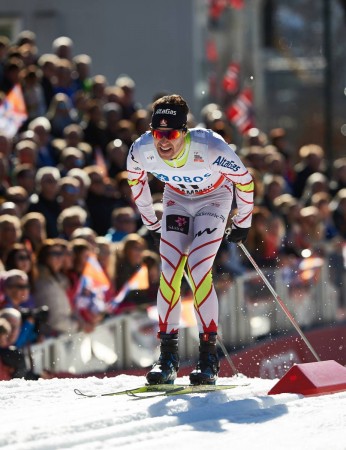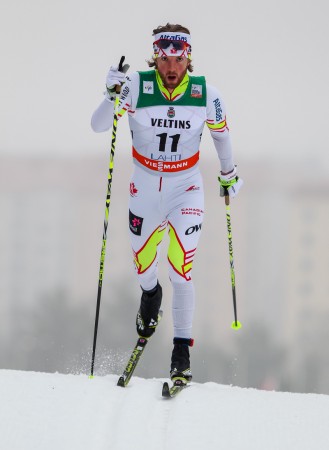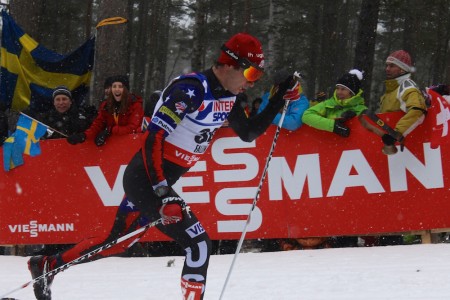
On a race course described by top American finisher Noah Hoffman as “super painful almost the entire time,” the North American men seemed to embrace the pulverizing eight, 3.75-kilometer, laps of Lillehammer’s famous Birkebeiner Stadium trails in Norway, and came away with several top results in Saturday’s 30 k skiathlon.
With five North American men in the top 25, four of which were Canadians, the group held its own.
“I was really impressed with all the guys today,” Canadian National Team Coach Justin Wadsworth said in a post-race phone interview about his athletes. “When the World Cups are in Norway, it’s the hardest place to score World Cup points.”
Proving his point, the home squad of Norwegians dominated the race, putting seven men in the top 10 and 13 in the top 30. Norway’s Martin Johnsrud Sundby continued his dominance, skiing away from the pack in the skate leg to post a 44-second victory over teammate Niklas Dyrhaug in second. A third Norwegian, Hans Christer Holund finished 2.9 seconds after Dyrhaug in third and was 46.9 seconds behind Sundby.
However, from the start of the race, the North Americans looked prime to spoil the homecoming. Canada’s Alex Harvey led early, attempting to execute his plan of sticking to the leaders. Together with American Erik Bjornsen, he clung to the chase pack 6 kilometers into the 15 k classic leg.
Bjornsen skied an impressive classic leg, nipping at the heels of Norway’s Petter Northug Jr. for a good portion of the first 15 k, and transitioned to the skate leg in 22nd, 59 seconds behind Sundby as the race leader. Meanwhile, Harvey’s classic race took on a different feel, with that fleeting glimmer of crashing the Norwegian party giving way to some tense moments as he drifted back around 40th place.
“Everyone was concerned at first to see Alex dropping back,” Wadsworth said.
Harvey, who stood on the podium a week ago at the World Cup opener in Kuusamo, Finland, echoed that concern.
“I had to change my plan pretty early in the race; the classic was really bad for me,” he said on the phone.
Although he continued to move up toward the end of the classic leg, on his second-to-last and final classic lap, he fought to stay in the game.
“I had to adapt the strategy. I was just fighting against myself and trying to push away the thoughts of dropping out,” Harvey said.

His persistence paid off. Once on skate skis, the top Canadian roared back, skiing briefly with his teammates Ivan Babikov, Devon Kershaw and Graeme Killick, then quickly accelerating all the way through to a 10th place, 1:57.1 behind Sundby.
According to Wadsworth, Harvey attributed his slower classic pacing to tired muscles.
“He got a lot of lactate going out of the stadium,” Wadsworth said.
The buildup is not surprising given the 64-meter climb. At the same time, Harvey overcame it.
“…Through the early part of the skate race he was able to clear that lactate, which is a really good sign for his fitness,” Wadsworth said.
Persistence was Harvey’s highlight.
“I pushed back those thoughts of dropping out but also kept pushing as hard as I could even though at one point I didn’t feel like I was fighting for anything,” he said.
He expressed happiness with his result, adding, “Anytime you’re in the top 10, you can’t really be disappointed about your day.”
Harvey’s teammates, Babikov, Kershaw and Killick, also contributed to Canada’s impressive day. All three bounced around the top 30 throughout the race before finishing in a cluster, with Killick in edging Russia’s Sergey Turyshev in a photo finish for 21st (+2:27.3), Kershaw placing 23rd (+2:30.6) and Babikov in 24th(+2:32.3).
They did not aim to race as a team, but the teammate proximity ended up reassuring Killick, who scored his first World Cup points on Saturday, partially by using his teammates and Hoffman, of the U.S. Ski Team, to maintain his pace.
“It was sweet skiing with the group there,” said Killick, 26, of the Canadian National Development Team. “Hoff is super strong up the climb and I sat in behind him on the second to last lap of the skate; he was beasting up the hill.”
With two career top 30s, one at 2015 World Championships (in which he was 19th in the 50 k classic mass start) and one at the 2014 Sochi Olympics (28th in the 50 k freestyle mass start), Killick’s capabilities were well known. His best outright World Cup result was also a big deal.
“For him to get his first World Cup points of his career is pretty exciting,” Wadsworth said. “You remember that day for sure as an athlete.”
Finishing right behind Killick was Kershaw, a Canadian World Cup Team veteran coming off a rough couple of years in terms of World Cup success relative to his historical record. Since the start of the World Cup last weekend, Kershaw has posted two previous top 30s in the opening World Cup stages in Kuusamo, Finland (where he was 24th in the 10 k freestyle and 23rd overall after the 15 k classic pursuit).
Although pleased with Saturday’s race, he described his hunger for podium results, referencing his 2011 World Championship gold with Harvey and overall World Cup runner-up finish that same year.
“We’re not popping champagne with a mid-twenties result with my history on the World Cup,” Kershaw said. “But at the same time, it’s a step in the right direction.”
“We’re not popping champagne with a mid-twenties result with my history on the World Cup, but at the same time, it’s a step in the right direction.” — Devon Kershaw, 23rd in Saturday’s 30 k skiathlon at the Lillehammer World Cup
Babikov reverberated this momentum swing on his personal website, explaining his 24th place finish as a positive sign. “…I’m getting my fitness and [what’s] most important some speed back.”
Skiing a similar race to Harvey was top U.S. finisher, Hoffman, who acknowledged battling a poor starting position on his way to finishing in 25th (+2:34.6).

“Starting from bib 63, you’re at the mercy of your ability to move up,” Hoffman said.
Injured for most of last season, Hoffman’s points put him outside the seeded group of starters, toward the back of the skiathlon mass start.
Despite his less-than-ideal positioning, he went into the race without a deliberate plan in an effort “to be thinking on [his] feet out there. Too often I’ve gotten sucked into trying to follow some sort of plan that I can follow no problem, but it doesn’t lead to the best result,” Hoffman said.
His flexibility paid off. He eased into it, moving up from 52nd around 7 k to 48th at 11 k, then all the way up to 28th at 22.2 k, 7.2 k into the skate leg. He wasn’t exactly sure why the first half of his classic leg started so slowly, but attributed his acceleration up the results sheet in the second half of the race to some of the skiers he transitioned with, including Norway’s Sjur Røthe and Italy’s Roland Clara, both of whom went on to finish in the top 20.
His teammate, Bjornsen skied opposite, throwing down an impressive classic leg but fading in the skate to finish 42nd (+5:09.1). In an email Bjornsen wrote that he “… felt great in the classic leg and was able to comfortably ski in the top 20.”
He didn’t realize he was so far up until he received a split that he was in 15th. Bjornsen explained his ski choice may have cost him in the skate portion as he picked a pair of skis anticipating snow rather than the rain that ended up falling.
U.S. Head Coach Chris Grover was excited about the first half of Bjornsen’s race.
“One of the untold stories that doesn’t show up as much in the results is Eric had a super classic leg. He was really flying through the classic leg and getting closer and closer to the guys in front of him,” Grover said. “Noah was a little the opposite, he wasn’t skiing the way he wanted to early in the classic race but … settled into it … And of course the skate race was good and [he] was able to move up quite a bit.”
Although temperatures hovered above freezing, around 39 degrees Fahrenheit, both the U.S. and Canadian wax techs nailed the wax by the team’s accounts. With the exception of Bjornsen’s skate-ski selection, it didn’t appear as though the wax made a difference for either team.
Other North American finishers included Canada’s Michael Somppi in 60th (+7:51.9) and American Kris Freeman in 64th (+8:56.5).
Racing continues Sunday with the men’s 4 x 7.5 k relay. Kershaw will start first for Canada, handing off to Harvey, followed by Babikov and Killick. For the U.S., Andy Newell will scramble followed by Bjornsen, Hoffman and Simi Hamilton.
Jeremy Blazar
New to the FasterSkier team, Jeremy has been involved in many facets of the ski community since he began ditching middle school to go skiing. When not daydreaming of the Birkie, he finds time to explore the fishing and trail-running opportunities of his new home, Seattle, Wash.



